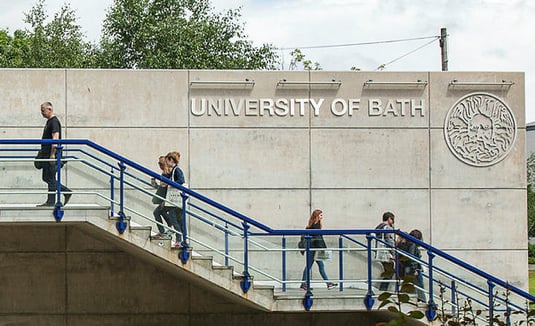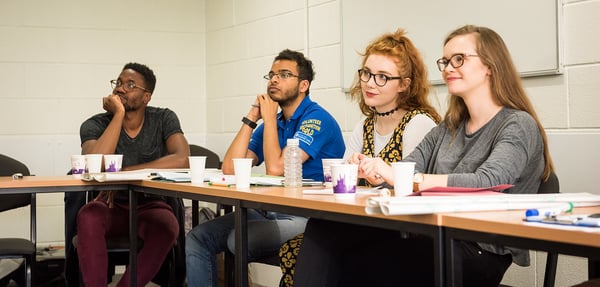
In his eight years at the University of Bath, Rob Hyde has been involved in constructing or refurbishing at least one building per year. The development of the new School of Management dwarfs them all. And on its journey to create spaces for students to collaborate long into the future, the University discovered Vivi.
The Challenge
When a University creates a new building with unique spaces designed for collaboration and engagement, the pressure is on to install the technology to make it work.
The Outcome
During the planning process, Vivi was rolled out across the existing campus. From the start, it was clear it could unlock the value in these new spaces and, as a result, it will be installed on every screen in the new building.

With the help of Vivi, the University of Bath has been able to:
1. Bring their philosophy of engagement, education and collaboration to life.
In its new GBP 70Million School of Management, the University is creating spaces to engage students and encourage them to collaborate. Vivi is the technology that will complement those stunning spaces.
2. Embrace a new way of working in response to a global pandemic.
With the new requirement for social distancing, students are now overflowing from lecture theatres into other areas. Vivi has freed lecturers to engage with and present to all of them, no matter which room they are in.
3. Remove unused technology and save money on installing unneeded ports.
With Vivi installed across the entire campus, it has created the opportunity to ‘thin out’ the amount of technology required. When it comes to saving money on ports and connections, Vivi is part of the solution, not part of the problem.
“Once the Maths and Engineering teams had trialed units, the demand for Vivi grew organically.
I didn’t have to push it out at all.”
Rob Hyde, Service Manager for Audio Visual, University of Bath.
Challenge
In 2016, the University of Bath celebrated its 50th year. Since its establishment in 1966, it has become one of the UK’s top-ten universities, with a reputation for research and teaching excellence. The question was how to continue that half-century of success and go on inspiring and innovating for the next 50 years.
The University saw the opportunity to bring its School of Management together in one building. That meant constructing a new and exciting space to allow teachers and students across eight buildings to come together.
The design process began 3.5 years ago, and the University was clear from the outset that it wanted to create a 21st Century learning and research environment. The spaces it incorporated into the plans were designed to enable effective teamwork and support the University’s key philosophies of engagement, education and collaboration. Alongside plans for traditional learning spaces, the building would include a Student Entrepreneurship Lab, an Employment Hub and a Behavioural Research Lab.
As part of the drive to create a space to inspire and innovate, the design included plans for boothed Harvard Theatres. These are unique project spaces designed in the shape of a horseshoe for small groups of four or five students. Rob Hyde, Service Manager for Audio Visual, describes them as something similar to small delegations at the UN. From this project space, the groups will be able to share their work with all other project groups, as well as the main display.
Of course, bringing those spaces to life requires the right technology. That responsibility falls to Hyde.
Solution
About two years ago, Hyde bumped into Vivi founder, Lior Rauchberger, at an EdTech exhibition. At the time, he was looking for a tool to allow lecturers to present remotely. The need was for students and lecturers to present to large groups from wherever they were—from project groups to 100-seat PC labs. Until that point, he had tried several solutions. None managed to fit the bill; either they caused issues that the network security team couldn’t approve, or they didn’t offer the right functionality.
When none of Hyde’s team could make a test Vivi unit do anything it wasn’t expected to, he knew it warranted a trial. Ten units were tested in different areas across the campus. Maths and Engineering lecturers liked what they saw and wanted more. From there, the demand for Vivi grew organically across the campus. Hyde says he didn’t have to push Vivi out at all.
Vivi units are now in every single teaching space at the University of Bath. Alongside their role in traditional learning areas, they are the technology that will bring the collaboration zones in the new School of Management building to life.
In addition, the School is installing a 3m LED wall in the reception area of the building. Like every other screen in the building, it will be Vivi enabled, which will allow reception staff to cast relevant messages to visitors and students alike.

Result
While construction is still underway, the University continues to benefit from its decision to implement Vivi. Until the pandemic struck in March, Vivi’s usage metrics showed that it was becoming more and more embedded in the way lecturers communicated with their students.
After the first COVID wave—and not to anyone’s great surprise—the usage numbers dropped, as fewer people were on campus. As students began to return, however, the University unlocked something from Vivi that it hadn’t expected. Rules were put in place that limited the number of people allowed in classrooms. It meant students, though participating in the same lecture, could be sitting in an entirely different room. Vivi has linked those disconnected classes together. It has enabled lecturers to wander around and interact with the various groups while broadcasting their screens to different rooms and sharing prompts for each group to discuss.
Not only has the new building represented an opportunity to add new technology, but it has also allowed Hyde to take the decision to remove unused technology. Unfortunately, not all tools come with the user reporting that Vivi has. In some cases, it has taken him as much as six months to identify whether certain technologies are being used or not. Having the confidence to reduce the number of inputs on lecterns down from four to one, and knowing it wouldn’t have a detrimental impact, has saved money. Of course, Vivi has helped with this process too. As a wireless presentation tool, Vivi doesn’t clog up ports unnecessarily.



